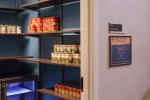This article was updated Mar. 10 at 1:53 p.m.
The instant ramen-slurping, overworked and penniless college student is a common trope. But it casts a light-hearted sheen on the serious issue of food insecurity, or the lack of reliable access to affordable, nutritious food.
Students who struggle to maintain a healthy, balanced diet are more likely to suffer from anxiety and depression, which in turn can make school more challenging than it should be. Food insecurity affects 42 percent of students across the entire University of California system.
The most convenient way UCLA can address this challenge is through the Community Programs Office Food Closet, which is located in the Student Activities Center and provides free canned foods and snacks for students. CPO relies on donations to purchase items provided in the food closet.
But the food closet has limited options, and students who come later in the day may not get fresh produce, said Jessica Yen, co-director of Hunger Project, a student group that mentors, educates and serves hot meals to homeless individuals.
The most recent attempt to address this lack of healthy meal options was a student-led collaborative effort called Bruin Dine. The program was based on the ingenious idea of taking leftover food from UCLA’s dining halls and distributing it to students twice a week. Yen, who helped coordinate the program, said its goal was to reduce food waste while providing students with warm, healthy meals. UCLA Dining strongly supported the initiative, said Alison Hewitt, a UCLA spokesperson. But Bruin Dine only served food for one night, Feb. 15, before temporarily halting operations due to health code violations.
Bruin Dine reveals the demand for programs that provide nutritious meals to those who would otherwise not have access to them. But its temporary hiatus underscores the need for UCLA’s administration to provide its own food security programs that don’t rely on student groups to lay the groundwork. The most straightforward way the administration can do this is to allocate funds to expand and improve the CPO Food Closet to ensure it has greater stocks of nutritious food.
Research conducted by the College and University Food Bank Alliance shows well-maintained, on-campus food pantries can effectively combat some food insecurity issues that students face. Food pantries’ flexible opening hours and simple operations make them easy to establish, and they have the additional benefit of being in close proximity to students.
UCLA students have formed the campus’ most impactful on-campus food security programs themselves. Student groups such as Hunger Project, Swipe Out Hunger and Bruin Shelter have worked with food-insecure students to provide consistent, healthy meals.
In fact, UCLA Dining has a habit of following the lead of student groups. Swipe out Hunger, for example, a long-running program that converts donated student meal swipes into dining hall credits and food, was also backed by UCLA Dining. But like Bruin Dine, Swipe Out Hunger had to navigate through a maze of regulations to get the program running.
Students should not have to take it upon themselves to develop and manage innovative food security programs. Instead, the university needs to take the lead on these programs, using suggestions and insight from students. Expanding and improving the food closet is the best way to start doing that.
While UCLA already has programs that address food insecurity, they often fall short of their full potential. For example, 580 Cafe, a campus space for students to meet and take food for free from a small pantry, often hosts dinner events once every two weeks, though the schedule varies by month, and may put off students because it is religiously affiliated.
Even the CPO Food Closet was initiated by a student before it became institutionalized. And it is important to note the school’s designation of the service is a “closet,” not a “pantry.” Unlike other universities, which provide large spaces to stock a variety of nutritious products, UCLA offers a cramped, closet-sized space with limited food options. Yen also noted that while she and other students are grateful the closet exists, many others are not even aware of its existence. This is an indication that UCLA hasn’t gone far enough to publicize the service.
In comparison, the food pantry at UC Irvine, a school with 10,000 fewer students than UCLA, provides a wide variety of fresh produce, canned and boxed goods, as well as frozen foods students can pick from in a large, spacious area. UCI also provides livestreams of its food pantry to allow students to stay up-to-date with its daily contents.
While UCLA may not have the space for an expansive pantry, it can certainly take the initiative in addressing food insecurity on campus by ensuring the CPO Food Closet is consistently stocked with diverse, nutritious foods. The university can also better raise awareness about its food closet, something UCI managed by hiring a full-time food access and security coordinator to develop the pantry by expanding its physical space and creating awareness campaigns.
Improving the food closet is far from an overarching solution to food insecurity, however. It is merely a feasible addition to an existing program that students already use. Expanding the food closet can complement the existing lottery-based cooking classes provided by UCLA Residential Life, a resource that not all students can make use of.
And UCLA can kickstart other initiatives – a university-managed iteration of Bruin Dine, for example, that doesn’t leave it to students to figure out how to navigate UCLA Dining’s complex matrix of rules.
The university has shown its support for food security, and student groups have benefitted from that. But UCLA, not exam-weary students, should be driving the food security efforts in Westwood.
